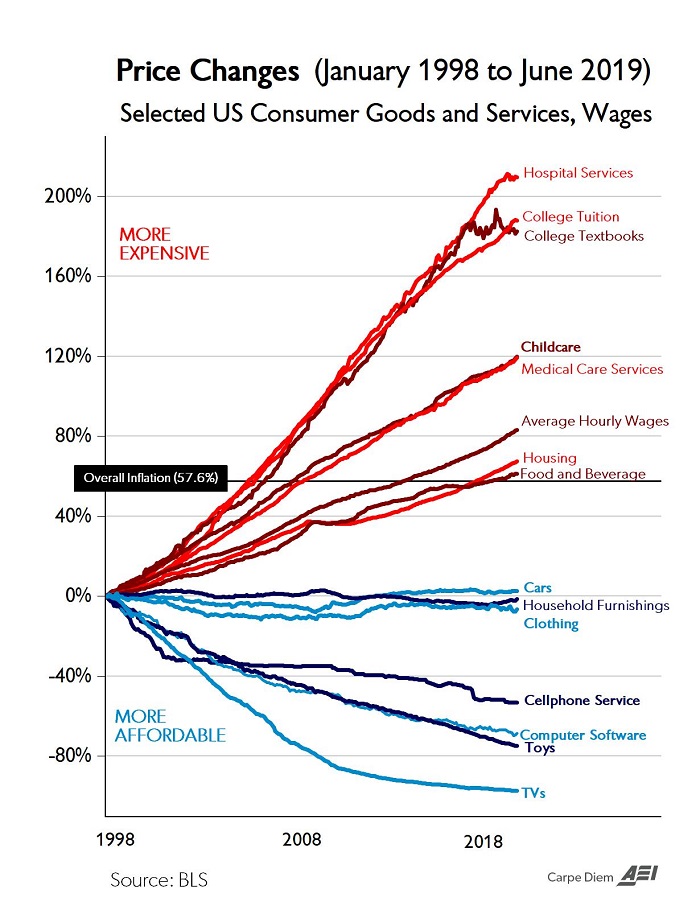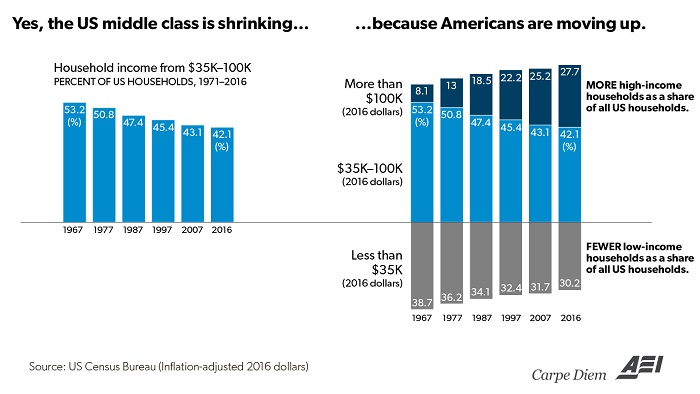By Richard Morrison of CEI.
"Recently billionaire philanthropist Eli Broad called for a wealth tax
in The New York Times and fellow billionaire Ken Fisher responded in
USA Today with a challenge that wealthy Americans (and the rest of the
country) would be better off with the very wealthy investing their money
in further for-profit enterprises. That’s a pretty stark contrast, and
one that shows off two very different attitudes toward wealth and
prosperity in America.
Broad’s op-ed highlights issues including “the shrinking middle
class, skyrocketing housing and health care costs.” His assumption seems
to be that more money, taxed from the wealthy and spent by Congress, is
going to be the solution to these ostensible problems. That seems
unlikely.
Let’s take just his first concern. As it turns out, we do not have a
middle class economic crisis in America. But we may have an
inability-to-understand-economic-dynamism problem. As Brad Schiller, an
emeritus professor of economics at American University wrote in the Los Angeles Times earlier this year:
As proof, proponents of [the shrinking
middle class] view point to government data showing that the median
household income (adjusted for inflation) fell from $60,002 in 2000 to
only $58,476 in 2015.
But in fact, the whole notion of a shrinking middle class is a myth. Here’s why.
When you compare household incomes over
time, you have to look at identical households. The census defines a
household as one or more persons living in the same abode. Fifty years
ago, only 15% of all U.S. households had a single occupant. By 2017 that
percentage had nearly doubled, to 28% percent. In just the last 10
years, the percentage has increased by three points. So, the typical
household today is much smaller.
There’s more to the myth of the shrinking middle class than that, but
Schiller’s op-ed is a great start. It’s true that, as a statistical
construct, fewer people
are in the middle class that in previous decades, but that’s because
many of them have joined the upper class. The American Enterprise
Institute’s Mark Perry blogged about these trends earlier this year, specifically in regards to home ownership:
America’s middle class has been shrinking
over time, from 61% of US households in 1971 to only 50% in 2015, when
middle class is defined as households earning between two-thirds and
twice the median household income. And that middle-class shrinkage
apparently implies that there is a “widening gap between what people
earn and the housing that is affordable to them”…
However, there are at least two serious
issues and questions that need to be addressed: a) if the middle class
did shrink, where did they go? and b) is housing really becoming less
affordable for Americans?
It will no doubt surprise Broad and his fellow tax-us-rich-folks-more friends that most of the vanished middle-class actually ascended the economic ladder than slipped down it.
The analysis debunking the “disappearing middle class” didn’t all accumulate over the last year, either. A 2012 article
by the Brookings Institution’s Ron Haskins points to a misleadingly
narrow focus (looking at just the top 1%, rather than income by
quintile) as well as a dishonestly narrow definition of “income”
(ignoring the value of non-monetary work benefits and government
transfer payments). If we include the value of government benefits and
payments to low-income Americans, the problem of income inequality
begins to look very different:
What about those at the bottom, supposedly
floundering? Based only on their market income, the bottom 20 percent
lost about one-third of its income between 1979 and 2007. But when
[economist Richard] Burkhauser calculates the impact of government
transfers, the value of health insurance not paid for by households and
the decline in household size, the bottom 20 percent had about 25
percent more income in 2007 than 1979. Even the bottom is moving up.
It’s true that we, as a nation, could and should be doing even
better. Economic growth and real wages should be growing even more
robustly. But trying to create an imaginary crisis in opposition to real
data is not the way to get there. Nor, the evidence suggests, is more
government spending and regulation. When it comes to middle-class
Americans being squeezed by rising costs of important household items,
the industries in which we’ve seen the greatest prices increases have
been precisely those that are the most highly regulated. Again, from
AEI’s Mark Perry:"



No comments:
Post a Comment
Note: Only a member of this blog may post a comment.